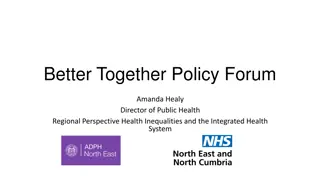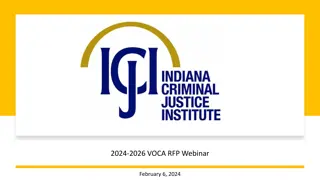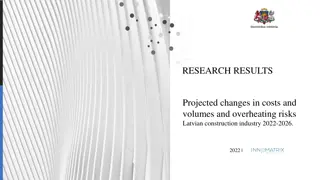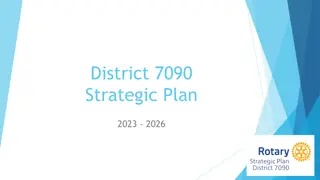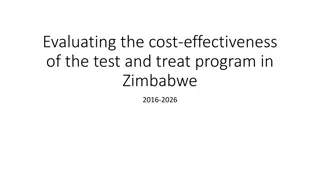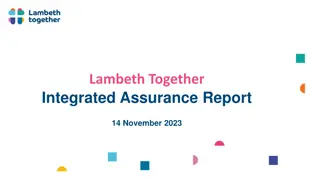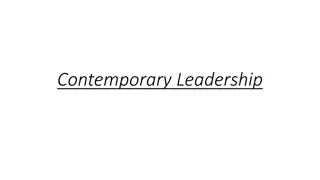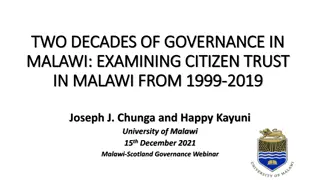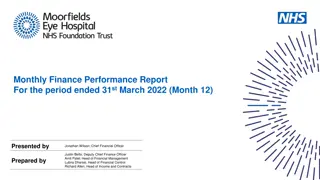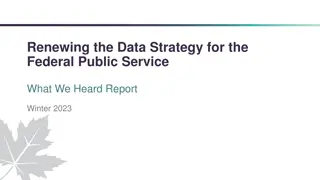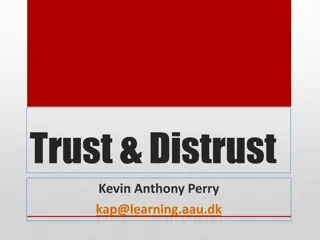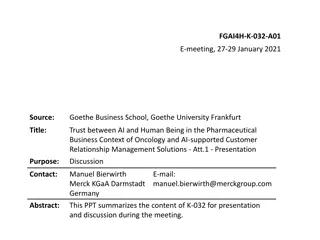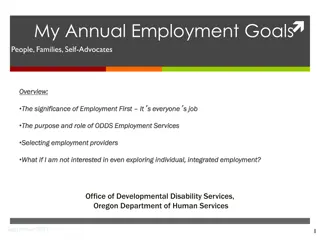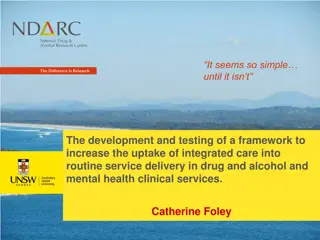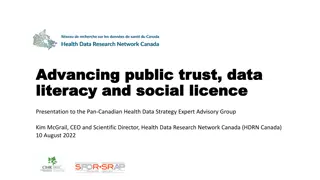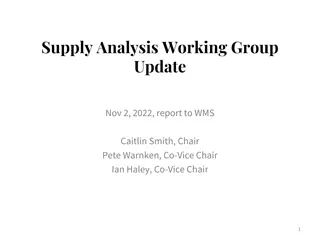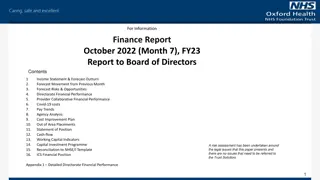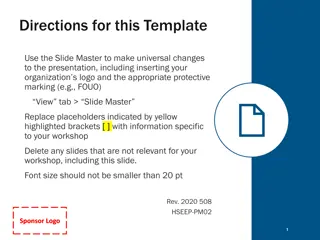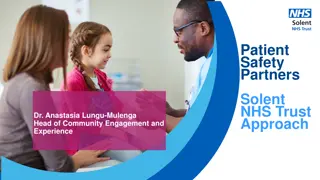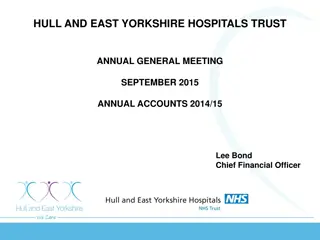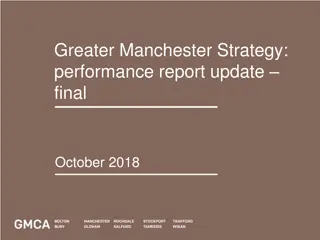Trust Strategy 2021-2026 Integrated Performance Report
The Trust's strategy for 2021-2026 focuses on delivering outstanding care through key strategic objectives: quality, people, sustainability, and research & education. The report highlights progress against these objectives, using key focus areas and Objective Key Results (OKRs) to track performance and ensure alignment with the Trust's vision and values.
Download Presentation

Please find below an Image/Link to download the presentation.
The content on the website is provided AS IS for your information and personal use only. It may not be sold, licensed, or shared on other websites without obtaining consent from the author. Download presentation by click this link. If you encounter any issues during the download, it is possible that the publisher has removed the file from their server.
E N D
Presentation Transcript
Integrated Performance Report (IPR) Report: Board meeting 28 July 2021 May 2021 data Assuring the Board on the delivery of the Trust s 4 strategic objectives; quality, people, sustainability and research and education Caring, safe and excellent
Section 1: Introduction to the Trust strategy 2021-2026 Caring, safe and excellent
Introduction to the Trust Strategy 2021-2026 Executive Summary: Martyn Ward, Director of Strategy and CIO Introduction to the Trust Strategy 2021-26 Oxford Health NHS Foundation Trust (OHFT, the Trust) has developed an organisational strategy for the five year period 2021-26. The aim of the strategy is to set the Trust s long-term direction, guide decision-making and address strategic challenges for example rising demand for and complexity of healthcare, recruiting and retaining a stable workforce, and ensuring sufficient resourcing. Following the publication of the 2021 NHS White Paper, the NHS is likely to change over the period of the strategy - shifting from a commissioner/provider model to one characterised more by system working and collaboration with healthcare partners (NHS, local authority, independent and third sector) focused on collectively improving overall population health and addressing health inequalities. The Trust s vision is Outstanding care by an outstanding team, complemented by the values of being Caring, Safe & Excellent. Flowing from the vision and values are four strategic objectives: 1. 2. 3. 4. Deliver the best possible care and outcomes (Quality) Be a great place to work (People) Make the best use of our resources and protect the environment (Sustainability) Become a leader in healthcare research and education (Research & Education) Key focus areas and Objective Key Results To move the strategy into a focus on delivery, each strategic objective has been developed into a set of key focus areas (workstream descriptors). The aim of the key focus areas is to identify priority activities and workstreams for the Trust over the coming years and to provide a bridge between the high-level ambitions of the strategic objectives and a set measures and metrics to track progress. Existing and new measures and metrics have been gathered and/or created using an Objective Key Results (OKRs) approach. OKRs allow for measurement of activities that contribute to key areas of focus and workstreams and will be reported to relevant Board committees and Board via an Integrated Performance Reporting approach. While the key focus areas are intended to be fixed for the lifespan of this strategy, the OKRs can be updated and added to as required. To enable this, the OKRs are an appendix to the main Trust strategy document. This approach allows for a consistency of approach for the strategy but the flexibility to adapt the metrics used to measure progress. For example, a specific OKR may be achieved and can then be replaced with a new target. This report reports delivery of the strategy and performance against the OKRs. Supporting data and narrative is supplied where there is underperformance. Caring, safe and excellent
Section 2: Trust Headlines Caring, safe and excellent
The arrows indicate whether the trend is up or down against the last reported figure Patients seen Caseload Activity Referrals Referrals Referrals Received Patients on caseload Attended contacts delivered No. distinct patients seen 6,471 to Adult Mental Health Services (incl IAPT). +14.8% increase on the 2019/20 monthly average of 5,637 25,943 inAdult/Older Adult Mental Health (inc IAPT). +9.5% more than the 2019/20 monthly average of 23,697 31,541 in Adult Mental Health Services (inc IAPT). +36.3% higher than the 2019/20 monthly average of 23,144 14,720 in Adult Mental Health (inc IAPT). +22.7% more than the 2019/20 monthly average of 11,993 16,960 inChild & Adolescent Mental HealthServices. +12.3% more than the 2019/20 monthly average of 15,096 2,998 to Child & Adolescent Mental HealthServices. +26.6% increase on the 2019/20 monthly average of 2,368 5,703 in Child & Adolescent Mental Health Services. +5.9% more than the 2019/20 monthly average of 5,384 13,910 in Child & Adolescent Mental HealthServices. +23.5 higher than the 2019/20 monthly average of 11,262 133,387 inCommunity Services (exc OOH/MIU). -7.7% fewer than the 2019/20 monthly average of 142,120 (note excludes dental for FY19/20 comparison) 24,609 to Primary and Community Care Services inc OOH/MIU). +3.1% increase on the 2019/20 monthly average of 23,862 76,557 in Primary and Community Care Services (inc OOH/MIU). -1.0% marginally lower than the 2019/20 monthly average of 77,316 32,860 in Primary and Community (inc OOH/MIU). -3.2% fewer than the 2019/20 monthly average of 33,948 Caring, safe and excellent
The arrows indicate whether the trend is up or down against the last reported figure Admissions Average Length of Stay (LOS) 64 days on Adult/Older Adult Mental Health wards (inc Rehab & PICU and exc leave/delay). +12.3% longer than the 19/20 average 84 to Adult/Older Adult Mental Health wards (inc rehab & PICU). +12.3% more than the 2019/20 monthly average 24 days on Community Hospital wards (exc delay). - 4% shorter than 19/20 average 131 to Community Hospital wards. +15.9% more than the 19/20 monthly average 1798 days on Forensic (inc LD) wards (exc leave/delay). +96.5% longer than the 19/20 average 4 to Forensics wards (inc LD). -20.0% less than the 19/20 monthly average 119 days on CAMHS wards (exc leave/delay). +46.9% longer than 19/20 average 6 to CAMHS wards. -33.3% less than the 19/20 monthly average 21 days on Eating Disorders wards (exc leave/delay). - 27.6% shorter than 19/20 average 5 to Eating Disorders wards. -37.5% less than the 19/20 monthly average Caring, safe and excellent
The arrows indicate whether the trend is up or down against the previous last reported figure Quality Finance L&D Workforce Appraisals, SIs, Complaints & Feedback New starters, Leavers & HR mgmt. cases resolved Supervision & Training Finance 270 appraisals completed in May 2021 +34% more than May 2020 at 202 completed 6 Serious Incidents occurred May 21. 1 more than in April 21 and the same as May 2020. Same as average number received in 2020/21. 17 Formal Complaints received in May 21 same as average for 2020/21. 3 more than in April 21. Levels of formal complaints in 20/21 lower than comparators- Berkshire, CNTW & East London. FFT patient feedback - community services: 83% said Very Good May 21 (national ave. 83%). Mental health: 68% said Very Good May 21 (national ave. 62%). 479kspent on Out of Area Placements in month 2. +106% higher than the 2019/20 monthly average of 232k but lower than month 1 72 new starters in month 2. Lower than month 1 (123) and -9% lower than the 2019/20 monthly average of 79 2781 Supervision sessions carried out in May 2021 +26% from May 2020 of 2206 55 leavers in month 2. Lower than last month (63) and -13% lower than the 2019/20 monthly average of 63 4271kspent on Agency Staff in month 2. +110% higher than the 2019/20 monthly average of 2034k and higher than month 1 ( 4180k) 3329 Training courses attended (digital and classroom). + 78% compared to May 2020 of 1867 training courses 22 HR management cases resolved.Higher than last month (15) and -8% fewer than the 2019/20 monthly average of 24 114k spent on travel claims. -53% lower than the 2019/20 monthly average ( 238k) Caring, safe and excellent
Section 3: Delivery of the NHS Oversight Framework Caring, safe and excellent
National objective: Compliance with the NHS Oversight Framework This year, the NHS Oversight Framework indicators that have targets are; Target National position Latest Trust Position Trend (N1) A&E maximum waiting time of four hours from arrival to admission/transfer/ discharge 95% 81.3% (Jun) 95.7% (Jun) (N2) People with a first episode of psychosis begin treatment with a NICE-recommended care package within two weeks of referral (MHSDS) (quarterly) 56% 73.4% (Mar) 87.3% (Jun) (N3) Data Quality Maturity Index (DQMI) MHSDS dataset score - reported quarterly 95% 68.2% (Dec) 97.9% (Mar) (N4) IAPT - Percentage of people completing a course of IAPT treatment moving to recovery (quarterly) 50% 49.6% (Mar) 55% (Mar) (N5) IAPT - Percentage of people waiting six weeks or less from referral to entering a course of talking treatment under Improving Access to Psychological Therapies (IAPT) 75% 92.4% (Mar) 98.5% (Mar) (N6) IAPT - 18 weeks or less from referral to entering a course of talking treatment under IAPT 95% 98.7% (Mar) 99.8% (Mar) (N7a) Inappropriate out-of-area placements (OAPs) for adult mental health services - OAP bed days used (Bucks) 0 n/a 0 (May) (N7b) Inappropriate out-of-area placements (OAPs) for adult mental health services OAP bed days used (Oxon) 0 n/a 8 (May) Governance: Executive Director: Director of Strategy and CIO | Responsible Committee: Quality Committee | Responsible reporter: Claire Page Executive Summary: Martyn Ward, Director of Strategy and CIO About: The NHS Oversight Framework replaced the provider Single Oversight Framework and the clinical commissioning group (CCG) Improvement and Assessment Framework (IAF) in 2019/20 and informs assessment of providers. It is intended as a focal point for joint work, support and dialogue between NHS England and NHS Improvement, CCGs, providers and sustainability and transformation partnerships, and integrated care systems. The table above shows the Trust s performance against the targeted indicators in the framework. Areas of non-compliance are explained overleaf. Performance: Overall performance is good with all indicators consistently achieved over the past 12 months, with the exception of the number of inappropriate out of area placements in Oxfordshire. Please see overleaf for more information Caring, safe and excellent
National Objective: areas of underperformance Objective Key Result (OKR) Target Actual Objective Key Result (OKR) Target Actual (N7a) Inappropriate out-of-area placements (OAPs) for adult mental health services aim to reduce OAP bed days used (Bucks) (N7b) Inappropriate out-of-area placements (OAPs) for adult mental health services aim to reduce OAP bed days used (Oxon) 0 0 0 8 Executive Director commentary: Martyn Ward, Director of Strategy and CIO The issue and cause Trust did not achieve the OAPs target in Oxon in May, however, the number of OAPs used is decreasing as illustrated above. The Trust continues to have reduced bed capacity as a result of Infection Prevention Control (IPC) guidance. The Trust has been operating throughout the year with up to 15% less capacity in the Adult and Older Adult Mental Health wards. The interim closure of beds has resulted in additional Out of Area placements which the Trust has mitigated by purchasing a block contract of 10 beds. The plan or mitigation Following recent NHSE/I guidance the Trust has reviewed the use of OAPs and is assured that continuity of care principles are adhered to. Reporting from April 2021 reflects this change and please note this change when viewing performance against historical trend. May 2021 locally reported usage was 0 OAPs in Bucks, and 8 OAPs in Oxon. In April, changes to IPC guidance have allowed the facilitation of patients who have completed their 14- day period of isolation and are COVID negative to be repatriated to vacant Oxford Health beds. Therefore, maximising bed capacity and reducing the need to purchase further inappropriate OAP. Caring, safe and excellent
Section 4: Delivery of our four strategic objectives Caring, safe and excellent
Objective 1: Quality - Deliver the best possible care and outcomes (data May 2021) Governance Executive Director: Chief Nurse | Responsible Committee: Quality Committee This year, our Objective Key Results (OKRs) are; Target Comm Services Oxon & BSW Bucks LD Forensics Pharm Trust* Trend (1a) Clinical supervision completion rate 85% 64% 53% 65% 75% 76% 21% 64% (1b) Staff trained in restorative just culture 20 - - - - - - 8 (1c) 100% achievement of the year 1 Race Equality Framework actions - quarterly 100% - - - - - - n/a n/a (1d) Cases of preventable hospital acquired infections (YTD) <3 - - - - - - 0 (1e) Reduction in use of prone restraint by 25% in year 1 figures YTD <240 over 12mths - 18 6 - 11 - 35 YTD (1f) Patient safety partners employed to be part of the governance structure quarterly 2 - - - - - - n/a n/a (1fa) Improved completion of the Lester Tool for people with enduring serious mental illness (SMI) (EIP teams) 90% - 74% 46% - - - 62.1% (1fb) Improved completion of the Lester Tool for people with enduring SMI (Community) 75% - 32% 49% - - 40.1% - (1g) Evidence patients have been involved in creating their care plan (bi-monthly audit) 95% No audits completed in month 86% - 100% - 93% 94% (1h) 30% of clinical staff in non-learning disability services have completed internal eLearning on autism 30% - - - - - - 1% * No national comparator/benchmarks available Caring, safe and excellent
Objective 1: Quality - Deliver the best possible care and outcomes Governance Executive Director: Chief Nurse | Responsible Committee: Quality Committee Executive Summary: Marie Crofts, Chief Nurse The Quality OKRs are a sub-list of the quality objectives which form the annual Quality Account. The objectives were identified following a review of our risks, themes from quality information, recovery work and feedback from stakeholders. Some of the key objectives are underperforming at this point in time. Please see overleaf for more information by measure on the cause of the underperformance and the plans to mitigate and improve performance. The P&I Team and BI Team are developing reporting from CareNotes to monitor the completeness of risk assessments and timeliness of CPA reviews, which will be included in future reports. The quarterly community mental health Care Programme Approach (CPA) clinical audit looks at the quality of documentation for these measures which we will also use to assess and improve performance the Q1 audit was completed in June 2021. The Trust has started the following Quality Improvement Projects to address the relevant OKRs in the Quality section; Positive and Safe reduction in restrictive practice Improving the Physical Health monitoring of patients with SMI Risk Assessment formulation and documentation Working with families and carers Measuring success of race equality framework for change Caring, safe and excellent
Objective 1: Quality; areas of underperformance (data from May 2021) Objective Key Result (OKR) Target Actual Executive Director commentary: Marie Crofts, Chief Nurse (1a) Clinical supervision completion rate 85% 64% The risk or issue The risk is staff may be struggling in their role and feel unsupported to manage difficult situations. The cause This is two-fold, supervision levels are likely to be higher than reported due to incomplete recording on OTR system combined with operational pressures due to responding and recovering from COVID-19. What is the plan or mitigation? A new Trust clinical supervision lead has been appointed to help embed supervision structures, to develop the quality of sessions. NHSE/I are funding Professional Nurse Advocates (PNAs) and we have a range of nurses on these courses which will support embedding of Restorative Supervision across our Trust. We are identifying different ways and activities to raise awareness and support staff/ managers. A supervision week is happening from 5-9th July which will have daily masterclass sessions focusing on different topics to share information and answer any questions. The new OTR system will also make it easier to record supervision sessions completed. Caring, safe and excellent
Objective 1: Quality; areas of underperformance (data from May 2021) Objective Key Result (OKR) Target Actual Executive Director commentary: Marie Crofts, Chief Nurse (1h) Reduction in use of prone restraint by 25% in year 1 Less than 20 a month (240 in 2021/22) The risk or issue Use of prone restraint carries risks and should be avoided and only used for the shortest possible time if needed. 35 YTD The cause YTD the position is 35 uses against a YTD target of 40, however in May 2021 the number of uses is high. Between 2020/21 Q4 and 2021/22 Q1 the number of prone restraints has increased, mostly due to a small number of patients and related to a patient's level of violence and aggression. What is the plan or mitigation? A large-scale QI project launched in May 2021 to reduce the use of restrictive practice, including prone restraint. 11 wards have started the project and will test a variety of ideas. Progress with actions and impact is monitored through the Positive and Safe Committee. On a weekly basis all prone restraint is reviewed, including looking at duration. Caring, safe and excellent
Objective 1: Quality areas of underperformance (data from May 2021) Actual Target Executive Director commentary: Marie Crofts, Chief Nurse Objective Key Result (OKR) (1fa) Improved completion of the Lester Tool for people with enduring serious mental illness (EIP teams) Context The indicator is based on the completion of the comprehensive Lester physical health assessment tool for patients with a serious mental illness. The tool covers 8 elements including smoking status, lifestyle, BMI, blood pressure, glucose and cholesterol, and the associated interventions. 90% 62.1% The risk or issue There is significant evidence that people with mental health issues are at higher risk of physical health morbidity and mortality. The cause The underperformance is due to a number of factors including staff capacity, re-prioritisation of work during COVID-19, equipment and a reduction in face-to-face work creating an issue due to some interventions requiring hands on intervention i.e. blood tests and blood pressure. Actual Target Objective Key Result (OKR) The plan or mitigation A recovery plan is in place being implemented by a task and finish group which reports regularly to the Quality and Clinical Governance Sub- Committee. Detailed reports have also been presented on the work to the Quality Committee and Trust Board, the last report went in May 2021. (1fb) Improved completion of the Lester Tool for people with enduring serious mental illness (Community teams for patients on CPA) 75% 40.1% Key actions being taken are around recruiting new physical health HCAs and leads, embedding consistency across the physical health clinics and ensuring teams have the appropriate monitoring equipment. There is also work underway to improve the access to data so that teams can monitor their performance more easily. The actions so far show a steady improvement since October 2020 across both the EIP and Community Teams. Oxon EIS has particularly improved to 74%. Wider community team demand and capacity pressures is having an impact on the rate of improvement. Caring, safe and excellent
Objective 1: Quality; areas of underperformance (data from June 2021) Objective Key Result (OKR) Target Actual Executive Director commentary: Marie Crofts, Chief Nurse (1g) Evidence patients have been involved in creating their care plan (bi-monthly clinical audit) 95% 93% The Inpatient Community Hospital and End of Life Care audits were not completed in April or June 2021 to be reported. When comparing the clinical audit to feedback received from patients throughIWGC (all services) in May 21 - 763 patients responded to this question and overall rated their involvement in care as 4.8 out of 5.0, a small increase from April 21. The risk or issue Patients are not always being involved in their plan of care impacting on their experience and outcomes. The cause This is a combination of needing to challenge practice/ approach and to improve ease of documentation. The plan or mitigation Improving patient involvement in their care is a key part of the Experience and Involvement Strategy. Work includes; Increasing the co-production of patients/ users in service changes and QI i.e. patient involvement in the mental health services transformation work and the Community Services Strategy. Supporting local patient forums held by clinical teams Employing more people with lived experience/ experts by experience Expanding the number of Peer Support Workers within clinical teams Identifying involvement champions in each team. Delivering co-production training. Executive Director commentary: Marie Crofts, Chief Nurse Context The information reported is from the relevant clinical audits completed in the reporting month. The clinical audit completed in May 21 was the Inpatient Essential Standards for mental health wards. The sample size was n=125 patient records. The Q1 community mental health Care Programme Approach (CPA) audit was completed in June 21. The CPA results in Q3 showed 86% of records demonstrated patient involved in creating their care plan, n=304. The Q4 audit was postponed due to team pressures. Caring, safe and excellent
Objective 2: People be a great place to work This year, our Objective Key Results (OKRs) are; Target Comm Services Oxon & BSW Bucks LD Forensics Pharm Corporate & Trading Trust National comparator Trust Trend (2a) Staff engagement index score (annual) to increase by 1% each year (to 74% by 2022) - Qrtly Best 75% Avg 72% Worst 66% >/=73% 73.1% 73.0% 68.9% 85% 71% 58% 73.2% 72.9% n/a ModHos 5.5%/ Peer 6.7% (2b) Reduce agency usage to NHSE/I target </=18.2% 11% 13% 11% 34.6% 10.1% -0.1% 3% 10.2% (2c) Reducing staff sickness to 3.5% over 2021/22 Allocate Insight 6.1% </=3.5% 5.43% 3.72% 3.45% 3.54% 5.89% 3.75% 2.68% 4.16% (2d) EDI OKR under review TBC None (2e) Reduction in % labour turnover 11.52% % ModHos 1.38% Q4 </=10% 12.21% 11.32% 17.2% 9.2% 6.0% 13.79% 11.97% (2f) Reduction in % Early labour turnover 16.02% 22.71% 16.22% 14.4% 7.5% 25.6% 34.13% 21.3% None ModHos Mar 2021 6.2%/ Peer 6.95% (2g) Reduction in % vacancies </=9% 8.90% 12.71% 13.17% 14.8% 20.7% -7.8% 9.31% 11.52% (2h) PDR compliance >=90% 81% 75% 71% 90% 85% 80% 47% 72% None (2i) PPST compliance >=90% 89% 81% 84% 85% 90% 87% 76% 84% None (2j) Number of Apprentices as % substantive employees >=2.3% 28.1% 5.16% None Caring, safe and excellent
Objective 2: People be a great place to work Governance Executive Director: Chief People Officer | Responsible Committee: People, Leadership and Culture Committee Executive Summary: Mark Warner, Interim HR Director Vacancy rates remain the key risk for the Trust and resulted in continued high use of agency staff to maintain safe staffing levels. Agency spend has reduced in month by 585k however remains a key priority for the Trust. International nurse recruitment has made good progress and remains to key initiative to reduce vacancies for Registered nurses. Turnover for new starters remains a concern and will be reported on separately moving forward. Sickness levels remain above target and the national benchmark, although the FirstCare initiative will not have shown any benefits in these metrics yet as they represent a 12 month rolling period. PDR compliance remains a concern at 71% and further action will take place to promote and re-launch appraisals and development discussions and a supervision lead is currently being appointed. Caring, safe and excellent
Objective 2: People; areas of underperformance Objective Key Result (OKR) Target Actual Objective Key Result (OKR) Target Actual </=3.5% (2c) Reducing staff sickness to 3.5% 4.15% (2e/f) Reduction in % labour turnover <10% 12% 4.2% 4.5% 4.1% 4.0% 3.5% 3.0% 2.5% 2.0% 1.5% 1.0% 0.5% 0.0% Apr May Jun Jul Aug Sep Oct Nov Dec Jan Feb Mar Trust position Target Executive Director commentary: Mark Warner, Interim Director of HR Executive Director commentary: Mark Warner, Interim Director of HR The risk or issue The sickness absence rate has increased marginally from 4.08% The risk or issue Staff turnover has remained unchanged from last month (12%). Throughout most of 2020 the turnover rate was above 12%. High levels of turnover will impact on agency spend and quality of patient care and staff experience. The cause Real-time data from First Care shows Long Term absence accounts for 53% of all absence, 46% short term. COVID related absence (medical and non-medical) has been reducing since February 2021. Unfortunately, stress/anxiety/depression/ psychiatric disorders and MSK are significant reasons for sickness absence. The cause The most common reason for leaving the Trust's employment over the past month has been retirement with 10 individuals leaving in May. The plan or mitigation Ongoing absence monitoring and utilisation of First Care data to inform support and management. The plan or mitigation Exit interview process has been refined. Retention of staff is a key challenge for NHS employers particularly after the difficulties many staff have experienced over the past 14 months: further analysis will be conducted to understand hot-spot areas needing particular focus. Return To Work Interviews compliance by managers is low and will be an area of focus for the Absence Team. Caring, safe and excellent
Objective 2: People; areas of underperformance Objective Key Result (OKR) Target Actual Objective Key Result (OKR) Target Actual (2h) PDR compliance (2g) Reduction in % vacancies </=9% 11.5% >/=90% 72% Executive Director commentary: Mark Warner, Interim Director of HR Executive Director commentary: Mark Warner, Interim Director of HR The risk or issue The vacancy rate has varied over the past 12 months (10.2% to 11.5%). The headline figure will mask spikes in turnover which require focus. The Risk or Issue PDR compliance does not improve and there will be no assurance that individuals are receiving appropriate feedback, support and development. The cause The vacancy rate is based on budgeted establishments which may not be an accurate reflection of actual vacancies. The Cause Some of the low compliance may be an issue of lack of recording rather than undertaking, which will be investigated. PDR were not seen as a priority during the COVID 19 pandemic. The plan or mitigation Significant recruitment activity in train: advertised vacancies 204; shortlisting stage 46; interview stage 103; pre-employment check stage 257. 252 offers were sent to successful candidates in May 2021. Mitigation Work with teams where compliance is low to provide guidance Move to on-line PDR so that recording is automatic (this will be possible with the new OTR introduced by the end of August) Caring, safe and excellent
Objective 2: People; areas of underperformance Objective Key Result (OKR) Target Actual (2i) PPST compliance >/=90% 84% Executive Director commentary: Mark Warner, Interim Director of HR The Risk or issue Compliance does not achieve 90% Information Governance rates not at 95% by end of June Reason Existing OTR system is not recording achievement automatically. Focus on PPST reduced during pandemic Some teams not seeing compliance as an issue. Mitigations Introduction of new OTR which records training in real time Work with teams who have low compliance to promote training Ensure appropriate classes are available Caring, safe and excellent
Objective 3: Sustainability; make the best use of our resources and protect the environment This year, our Objective Key Results (OKRs) are; Comm Services Oxon & BSW Bucks LD Forensics Pharm Corporate & Trading Trust Trend Trust (3a) Favourable working capital position reported against plan On Plan (3b) Favourable performance against financial plan (YTD) 0.3m favourable 1.5m adverse 0.2m adverse 0.4m adverse 0.2m favourable On plan On plan 0.3m adverse (3c) Cost Improvement Plan (CIP) delivery (YTD) 0.2m adverse (3d) 95% of estate to achieve condition B rating by 2025 (75% in 2021) 75% (3e) Delivery of estates related CO2 reduction target of 1623 tonnes by 2025 (10,862 in 2021) 10,862 tonnes - - - - - (3f) Achievement of all 8 targeted measures in the NHS Oversight Framework (see section 2 of this report) 6/8 - - - - - achieved Governance Executive Director: Director of Finance | Responsible Committee: Finance and Investment Committee | Responsible reporter: Alison Gordon/ Christina Foster Executive Summary: Mike McEnaney, Director of Finance The working capital position is a positive 0.9m which is on plan. The adverse variance to plan is driven by agency and bank spend particularly in the Oxon & BSW MH directorate. This is partly offset with a 1.1m underspend against the Covid allocation. The CIP plan for the year is 3.5m with 1.3m to be delivered in H1. 0.3m has been delivered at month 2. This is 0.2m adverse to plan due delays in implementation of agency savings as a result of Covid-19. Caring, safe and excellent
Objective 3: Sustainability areas of underperformance Objective Key Result (OKR) Trust Objective Key Result (OKR) Trust (3c) Cost Improvement Plan (CIP) Delivery 0.2m adverse (3b) Favourable performance against financial plan 0.3m adverse Executive Director commentary: Mike McEnaney, Director of Finance Executive Director commentary: Mike McEnaney, Director of Finance The risk or issue Financial performance against plan is 0.3m adverse at month 2. The risk or issue CIP Performance against plan is 0.2m adverse at month 2. The cause This is due to overspends in Bucks MH, Specialised and in particularly Oxon & BSW MH directorates. This is mainly caused by agency spend. The cause Engagement with the CIP Programme and the main scheme of reducing agency have been delayed due to Covid-19 The plan or mitigation International Recruitment programme and other plans as part of the Improving Quality, Reducing Agency programme to reduce agency spend Further engagement required for additional schemes to meet the plan The plan or mitigation The Trust s programme to improve quality and reduce agency spend should help reduce this pressure. Finance will work with directorates to understand the causes of the overspend and develop plans to bring the spend back in budget. Plans and budgets have not yet been agreed for new mental health investment funding for FY22. Any slippage on these plans will help offset overspends elsewhere. Caring, safe and excellent
Objective 3: Sustainability areas of underperformance Objective Key Result (OKR) Target Actual Objective Key Result (OKR) Target Actual (3d) 100% of estate to achieve condition B rating by 2025 (3e) Delivery of estates related Co2 reduction target of 1623 tonnes by 2025 75% 75% 10,862 10,862 Executive Director commentary: Mike McEnaney, Director of Finance Executive Director commentary: Mike McEnaney, Director of Finance The risk or issue In FY21, the Trust consumed 10,862 tonnes of Co2. The aim is to reduce consumption to 9030 by 2025. The improvement trajectory is shown on the graph above. The risk or issue In May 2021, 75% of the Trust estate has a condition B rating. The intention is to achieve 80% by 2025. The improvement trajectory is shown on the graph above The cause The Trust has an obligation under Statute and the NHS Contract to reduce carbon emissions generally, becoming a net carbon organisation by 2045. This objective relates only to plans to reduce carbon emissions linked to the estate The cause Lack of investment. In recent years the operational capital budget has been reduced by substantial amounts due to the Trust's financial position. This has impacted upon our ability to carry out works to maintain the condition of the estate. What is the plan or mitigation? The estates department has an action plan detailing potential schemes and associated investment required to reduce our carbon emissions. What is the plan or mitigation? A capital investment plan has been developed. Caring, safe and excellent
Objective 4: Research & Education Become a leader in healthcare research and education This year, our Objective Key Results (OKRs) are; Trust OKRs to be provided following Exec approval of R&D Strategy Governance Executive Director: Chief Medical Officer | Responsible Committee: Quality Committee Executive Summary: Karl Marlowe, Chief Medical Officer Caring, safe and excellent
Summary Action Plan - for all underperforming OKRs Objective OKR Target Actual Plan Resolved by? National (N7b) Inappropriate out-of- area placements (OAPs) for adult mental health services (Oxon) 0 8 In April, changes to IPC guidance have allowed the facilitation of patients who have completed their 14-day period of isolation and are COVID negative to be repatriated to vacant Oxford Health beds. Therefore, maximising bed capacity and reducing the need to purchase further OAP beds. Deliver the best possible care and outcomes (Quality) (1a) Clinical supervision completion rate 85% 64% A new Trust clinical supervision lead has been appointed to help embed supervision structures, to develop the quality of sessions. NHSE/I are funding Professional Nurse Advocates (PNAs) and we have a range of nurses on these courses which will support embedding of Restorative Supervision across our Trust. We are identifying different ways and activities to raise awareness and support staff/ managers. A supervision week is happening from 5-9th July which will have daily masterclass sessions focusing on different topics to share information and answer any questions. The new OTR system will also make it easier to record supervision sessions completed. Deliver the best possible care and outcomes (Quality) (1h) Reduction in use of prone restraint by 25% in year 1 (<240 in 2021/22/<20 per month) <40 35 TYD A large-scale QI project launched in May 2021 to reduce the use of restrictive practice, including prone restraint. 11 wards have started the project and will test a variety of ideas. Progress with actions and impact is monitored through the Positive and Safe Committee. On a weekly basis all prone restraint is reviewed, including duration. Deliver the best possible care and outcomes (Quality) (1fa) Improved completion of the Lester Tool for people with enduring serious mental illness - EIP teams 90% 62.1% A recovery plan is in place being implemented by a task and finish group which reports regularly to the Quality and Clinical Governance Sub-Committee. Detailed reports have also been presented on the work to the Quality Committee and Trust Board, the last report went in May 2021. Key actions being taken are around recruiting new physical health HCAs and leads, embedding consistency across the physical health clinics and ensuring teams have the appropriate monitoring equipment. There is also work underway to improve the access to data so that teams can monitor their performance more easily. Deliver the best possible care and outcomes (Quality) (1fb) Improved completion of the Lester Tool - Community teams for patients on CPA 75% 40.1% The actions so far show a steady improvement since October 2020 across both the EIP and Community Teams. Oxon EIS has particularly improved to 74%. Wider community team demand and capacity pressures is having an impact on the rate of improvement. Deliver the best possible care and outcomes (Quality) (1g) Evidence patients have been involved in creating their care plan (bi- monthly clinical audit) 95% 93% Improving patient involvement in their care is a key part of the Experience and Involvement Strategy. Work includes; Increasing the co-production of patients/ users in service changes and QI i.e. patient involvement in the MH services transformation work and the Community Services Strategy. Supporting local patient forums held by clinical teams Employing more people with lived experience/ experts by experience Expanding the number of Peer Support Workers within clinical teams Identifying involvement champions in each team. Delivering co-production training. Caring, safe and excellent
Summary Action Plan - for all underperforming OKRs Objective OKR Target Actual Plan Resolved by? Oct 21 Be a great place to work (People) (2c) Reducing staff sickness to 3.5% <3.5% 4.15% Ongoing absence monitoring and utilisation of First Care data to inform support and management. Return To Work Interviews compliance by managers is low and will be an area of focus for the Absence Team. Apr 22 Be a great place to work (People) (2e/f) Reduction in % labour turnover <10% 12% Exit interview process has been refined. Retention of staff is a key challenge for NHS employers particularly after the difficulties many staff have experienced over the past 14 months: further analysis will be conducted to understand hot-spot areas needing particular focus. July 22 Be a great place to work (People) (2g) Reduction in % vacancies <9% 11.5% Significant recruitment activity in train: advertised vacancies 204; shortlisting stage 46; interview stage 103; pre-employment check stage 257. 252 offers were sent to successful candidates in May 2021. Apr 22 Be a great place to work (People) (2h) PDR compliance 90% 72% Work with teams where compliance is low to provide guidance Move to on-line PDR so that recording is automatic (this will be possible with the new OTR introduced by the end of August) Work with teams where compliance is low to provide guidance Move to on-line PDR so that recording is automatic (this will be possible with the new OTR introduced by the end of August) Be a great place to work (People) (2i) PPST compliance 90% 84% Introduction of new OTR which records training in real time Work with teams who have low compliance to promote training Ensure appropriate classes are available Make the best use of our resources and protect the environment (Sustainability) (3b) Favourable performance against financial plan (YTD) On plan 0.3m adverse The Trust s programme to improve quality and reduce agency spend should help reduce this pressure. Finance will work with directorates to understand the causes of the overspend and develop plans to bring the spend back in budget. Plans and budgets have not yet been agreed for new mental health investment funding for FY22. Any slippage on these plans will help offset overspends elsewhere. Make the best use of our resources and protect the environment (Sustainability) (3c) Cost Improvement Plan (CIP) Delivery On plan 0.2m adverse International Recruitment programme and other plans as part of the Improving Quality, Reducing Agency programme to reduce agency spend Further engagement required for additional schemes to meet the plan Caring, safe and excellent
Section 5: Highlights from the Executive Managing Directors Caring, safe and excellent
Directorate highlights: Specialised (Learning Disabilities & Forensic) Executive Director commentary: Debbie Richards, Executive Managing Director, Mental Health & Learning Disabilities Specialised LD - a re-modelling of the Intensive Support Team as a result of a number of recent leavers is currently under consideration Specialised Forensic Clinical supervision, PDR compliance and mandatory continues to edge closer towards full compliance across medium secure and low secure services A nurse in our Milton Keynes Medium Secure Service saw the first Daisy award in the Trust which we are very proud of. The Sensory room on Evenlode is now operational. South Bucks Community Mental Health Hub - works complete, services and all staff relocated from Albert House, Valley Centre, Harlow House & Shrublands. Following an engagement process with local communities and with staff the Hub formerly known as Easton Street when in project phase has been named Saffron House After the saffron-drying district - adjacent to the area in High Wycombe which still bears the names Saffron Platt and Saffron Road. Saffron thrives best in fields that slope towards the sunlight and on or in a chalky well drained soil. Staff OD plan including Health & Wellbeing Events over the summer in place with formal opening scheduled for September. Workforce; following success in recruiting to wards at the Whiteleaf Centre, we are redoubling our efforts in community teams - we have some teams where we are paying additional focus including Older Adults Team in South Bucks. We have worked with Primary Care Networks in Bucks on the roll out of Community Mental Health Workers based in primary care. These roles are funded 50% Transformation Funds and 50% from primary care under the Additional Reimbursable Roles Scheme (ARRS) and are an important element of our Community Mental Health Transformation. All PCNs in Bucks have signed up to the scheme and we are now out to recruitment. Urgent care and In-patient acuity - the in-patient wards in Bucks have experienced high levels of demand and acuity recently, particularly with older adults many of whom have additional physical health conditions and frailty. We have seen a sustained increase on the urgent care services and overall use of our Health-based Places of Safety (S136 suites) - we are now sharing our analysis of their use through our network with the police, ambulance service and other providers as we have seen an increase in admissions from out of area which impacts on our capacity to serve Buckinghamshire and Oxfordshire Alternatives to Crisis - The Safe Haven in High Wycombe will extend to 7 days a week from August 2021 operating from 6.00pm 12 midnight. Building on the successful partnership with Oxford Health our new partners, Oasis, Connection Support and Citizen Advice Bucks, will further enhance our alternative to crisis model Caring, safe and excellent
Directorate highlights: Oxon & BSW Mental Health Executive Director commentary: Debbie Richards, Executive Managing Director, Mental Health & Learning Disabilities Workforce remains the most significant risk to service provision; whilst progress has been made on the actions in the recovery plan to address high vacancies/high use of agency in City AMHT, the service remains in business continuity; additional senior management support being provided to team development, recruitment and recovery in Adult Eating Disorders (Adult In-patient Oxford & community teams Oxford & Bucks adults & CYP) Workforce Virtual Recruitment Fair 9th & 12th June was successful and translated into a good number of applications; increased promotion of vacancies and opportunities in Oxfordshire have resulted in a significant increase in applications . Provider Collaboratives HOPE Eating Disorders work now progressing at pace to draft business case to secure partner and Trust Board support for go-live in October 2021. Demand and capacity modelling completed and being shared with NHSE and with partners. Current bed stock does not meet demand so innovative community-based models of care being worked up to resolve. Community Eating Disorders Dr R Bale attended the Oxfordshire HOSC to give an overview of the demand and capacity pressures currently being experienced and the work that is being undertaken with primary care to try better manage referrals and recover long waits. Thank you to staff working in Eating Disorders We were delighted to host a visit currently to Cotswold House by Robert Courts MP. CAMHS pressures remain as previously reported on waits for CAMHS beds across our PC foot-print and SE Region. Clinical discussions with acute paediatrics, community CAMHS and eating disorders service in both Buckinghamshire and Oxfordshire have taken place with input from Sussex Partnership Trust so we can learn from their experience of trialling a joint model of day-care. Caring, safe and excellent
Directorate highlights: Primary Care & Community Executive Director commentary: Ben Riley, Managing Director, Primary, Community and Dental Care Services Community Services pressure- worthy of note is the increased pressure- predominately non Covid related- being experienced by services across the Oxfordshire system. Flow through community hospitals remains a clear focus for us although delays due to reablement staff availability are creeping upwards. Our Out Of Hours and Minor Injury Units are reporting slight increases in activity and staff across our services, and indeed the system, are describing a rise in acuity of our patients. From a COVID perspective we are focused upon clarifying the vaccination status for our staff and are confident that the low reported figure previously referenced is an error of recording as opposed to vaccination aversion. The implications of staff isolation amongst staff affected by track and trace is increasingly problematic. Community Services Strategy- we are making good progress with this piece of work despite the operational pressures everyone remains under. A range of sessions sharing the initial work have been held internally, launching the first step in our staff engagement in this programme. A detailed plan is developing to ensure robust engagement with our staff across the directorate takes place. We will do this through a range of means including attending team meetings, listening and sharing events, and dedicated energy into making the Strategy page on the website informative and a place where staff can engage 24/7. The first wider stake holder engagement events regarding the development of the community strategy occurred today. Childrens Universal Services- continue to be challenged by high levels of demand especially in school aged children. Many schools have had significant numbers of children isolating causing further disruption and challenge to school work. We anticipate the demand for support through the summer holidays to be high and our staff who work all year round to be under significant pressure through the summer period. RSV cases are rising across Oxfordshire and anticipated to rise into the autumn and winter leading to pressure upon services we are working with OUHT colleagues to attend to this. Regarding services for Children with Complex care needs we are engaged in a project with the OUH to support the upskilling of our Childrens community nurses to manage more complex children at home. This is a project to essentially support winter surges in demand. The work to progress the Childrens Integrated therapy service remains unchanged however a new Start Well Lead Commissioner is now in post and engaging with our service leads to progress this. Urgent Community Response (UCR) this programme is beginning to gather strong momentum, we are beginning to gather patient stories that are able to demonstrate excellent outcomes for patients and their families/ carers. We recently partnered with SCAS to run a Perfect Week (over 3 days!) to test and grow the interface between SCAS staff and our UCR. The feedback was excellent- some learning but essentially able to demonstrate we can reduce the need for ambulance conveyance to acute care and deliver care closer to home that far better meets the needs of our patients. Recruitment is mixed in that it appears to be going well for UCR however this is starting to impact on other parts of the directorate as we move people around. Activity in this pathway is slowing improving and engagement with Primary Care is well underway to inform them of the service available to them outside of acute. We have had some excellent GP feedback that we are sharing as part of this primary care rollout. Caring, safe and excellent








